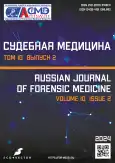Forensic medical characterization of sudden death in young people with connective tissue dysplasia according to the data of the Bureau of Medical Examinations of Moscow City
- Authors: Barinov E.K.1,2, Shigeev S.V.3, Kislov M.A.4, Globa I.V.5, Velenko P.S.5, Romanova O.L.2,6, Bychkov A.A.3,5, Gritsenko E.A.5, Gruhovskiy S.V.3, Novikov E.M.7
-
Affiliations:
- Russian University of Medicine
- Peoples' Friendship University of Russia
- Bureau of Forensic Medical Expertise
- The Russian National Research Medical University named after N.I. Pirogov
- The First Sechenov Moscow State Medical University (Sechenov University)
- Avtsyn Research Institute of Human Morphology of Federal state budgetary scientific institution "Petrovsky National Research Centre of Surgery"
- Medincenter ― branch Main Administration for Service to the Diplomatic Corps
- Issue: Vol 10, No 2 (2024)
- Pages: 201-209
- Section: Original study articles
- URL: https://journals.rcsi.science/2411-8729/article/view/262744
- DOI: https://doi.org/10.17816/fm15397
- ID: 262744
Cite item
Full Text
Abstract
BACKGROUND: Sudden death is an urgent problem of modern public healthcare, with prevalence in the Russian Federation. The wide range of causes and data scarcity led to the complexity of diagnosis and interpretation of pathologic changes at autopsy. This study presents an epidemiologic analysis of the causes of sudden death in a young population.
AIM: To provide a forensic medical description of cases of sudden death of young people with connective tissue dysplasia using data from forensic autopsies conducted at the Bureau of Medical Examinations of the Moscow City Health Department.
MATERIALS AND METHODS: A sample study of 48 corpses of young people aged 18–44 years who died suddenly, was performed based on data from the Forensic Medical Examination Bureau of the Moscow Department of Health. The protocols for examining the corpse at the scene of the incident, medical records were analyzed comprehensively. An extended description of the external and internal examinations of corpses was performed, and materials for histological, histochemical, and immunohistochemical studies were collected.
RESULTS: Cardiovascular pathologies were the main cause of sudden death in young people. In some cases, an asthenic type was established with the following signs: high stature, elongated chest with an acute epigastric angle, poorly defined subcutaneous fatty tissue, weight less than the age norm, and narrow shoulders. Pathological changes were identified in the sternum, spine, limbs, dental status, and internal organs, which corresponded to connective tissue dysplasia. A correlation was noted between sudden death in young people and asthenic skeletopathy with exposure to extreme factors such as physical stress, psychoemotional stress, and previous infectious diseases. In most cases of sudden death, pathological changes in blood vessels were diagnosed in young people.
CONCLUSION: The development of a modern comprehensive scientific and methodological approach is necessary to assess pathomorphological changes in young people who died suddenly.
Full Text
##article.viewOnOriginalSite##About the authors
Evgeny Kh. Barinov
Russian University of Medicine; Peoples' Friendship University of Russia
Email: ev.barinov@mail.ru
ORCID iD: 0000-0003-4236-4219
SPIN-code: 2112-4568
MD, Dr. Sci (Med.), Professor
Russian Federation, Moscow; MoscowSergey V. Shigeev
Bureau of Forensic Medical Expertise
Email: Shigeev@mail.ru
ORCID iD: 0000-0003-2219-5315
SPIN-code: 3116-2928
MD, Dr. Sci. (Med.)
Russian Federation, MoscowMaksim A. Kislov
The Russian National Research Medical University named after N.I. Pirogov
Email: smedik@gmail.com
ORCID iD: 0000-0002-9303-7640
SPIN-code: 3620-8930
MD, Dr. Sci. (Med), Assistant Professor
Russian Federation, MoscowIrina V. Globa
The First Sechenov Moscow State Medical University (Sechenov University)
Author for correspondence.
Email: ig_92@mail.ru
ORCID iD: 0000-0002-7185-4324
SPIN-code: 3976-6782
MD, Cand. Sci. (Med.)
Russian Federation, MoscowPavel S. Velenko
The First Sechenov Moscow State Medical University (Sechenov University)
Email: velenko_p_s_1@staff.sechenov.ru
ORCID iD: 0000-0003-2800-1454
SPIN-code: 6649-3580
MD, Cand. Sci. (Med.), Assistant Professor
Russian Federation, MoscowOlga L. Romanova
Peoples' Friendship University of Russia; Avtsyn Research Institute of Human Morphology of Federal state budgetary scientific institution "Petrovsky National Research Centre of Surgery"
Email: romanova-ol@rudn.ru
ORCID iD: 0000-0001-6356-9251
SPIN-code: 6727-9170
Cand. Sci. (Biol.), Assistant Professor
Russian Federation, Moscow; MoscowAlexey A. Bychkov
Bureau of Forensic Medical Expertise; The First Sechenov Moscow State Medical University (Sechenov University)
Email: bychkov_a_a@staff.sechenov.ru
ORCID iD: 0000-0001-6741-6498
SPIN-code: 4042-7275
MD, Cand. Sci. (Med.), Assistant Professor
Russian Federation, Moscow; MoscowElizaveta A. Gritsenko
The First Sechenov Moscow State Medical University (Sechenov University)
Email: mirukawa27@gmail.com
ORCID iD: 0009-0009-8074-6665
Russian Federation, Moscow
Sergey V. Gruhovskiy
Bureau of Forensic Medical Expertise
Email: gruhovskiy@mail.ru
ORCID iD: 0000-0001-9849-7825
SPIN-code: 7734-4020
MD
Russian Federation, MoscowEgor M. Novikov
Medincenter ― branch Main Administration for Service to the Diplomatic Corps
Email: dr.ENovikov@gmail.com
ORCID iD: 0000-0002-6851-5786
SPIN-code: 4295-8682
MD, Cand. Sci. (Med.)
Russian Federation, MoscowReferences
- Maron BJ, Maron MS, Maurer MS, et al. Cardiovascular diseases that have emerged from the darkness. J Am Heart Association. 2021;10(20):e021095. EDN: HTRZQB doi: 10.1161/JAHA.121.021095
- Klochihina OA, ShprahVV, Stahovskaya LV, et al. An analysis of the long-term stroke morbidity and mortality in the regions of the Russian Federation included in the federal patient assistance reorganization program. S.S. Korsakov J Neurol Psychiatry. 2020;120(12-2):37–41. EDN: GYMLMJ doi: 10.17116/jnevro202012012237
- Skjelland M, Zamani M, Hetlevik S, et al. Increased endothelial activation in patients with mixed connective tissue disease. J Stroke Cerebrovasc Dis. 2020;29(2):104563. doi: 10.1016/j.jstrokecerebrovasdis.2019.104563
- Zemcovskij EV, Timofeev EV, Malev EG. Inherited disorders (dysplasia) of the connective tissue. Which of the two existing national recommendations is preferable? Pediatr. 2017;8(4):6–18. EDN: ZDMAQN doi: 10.17816/PED846-18
- Boot E, Ekker MS, Putaala J, et al. Ischaemic stroke in young adults: A global perspective. J Neurol Neurosurg Psychiatry. 2020;91(4):411–417. EDN: EJFGVJ doi: 10.1136/jnnp-2019-322424
- Bojcov SA, Shahnovich RM, Erlih AD, et al. Registry of acute myocardial infarction. REGION-IM — Russian Registry of Acute Myocardial Infarction. Kardiologiia. 2021;61(6):41–51. EDN: EVBEBV doi: 10.18087/cardio.2021.6.n1595
Supplementary files











